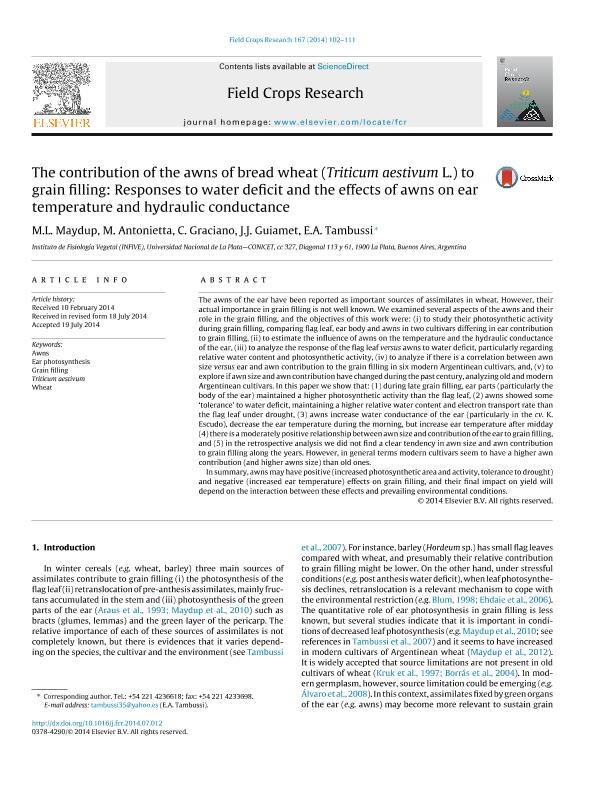Mostrar el registro sencillo del ítem
dc.contributor.author
Maydup, Maria Luján

dc.contributor.author
Antonietta, Mariana

dc.contributor.author
Graciano, Corina

dc.contributor.author
Guiamet, Juan José

dc.contributor.author
Tambussi, Eduardo Alberto

dc.date.available
2018-01-19T19:08:53Z
dc.date.issued
2014-08
dc.identifier.citation
Maydup, Maria Luján; Antonietta, Mariana; Graciano, Corina; Guiamet, Juan José; Tambussi, Eduardo Alberto; The contribution of the awns of bread wheat (Triticum aestivum L.) to grain filling: Responses to water deficit and the effects of awns on ear temperature and hydraulic conductance; Elsevier Science; Field Crops Research; 167; 8-2014; 102-111
dc.identifier.issn
0378-4290
dc.identifier.uri
http://hdl.handle.net/11336/34001
dc.description.abstract
The awns of the ear have been reported as important sources of assimilates in wheat. However, their actual importance in grain filling is not well known. We examined several aspects of the awns and their role in the grain filling, and the objectives of this work were: (i) to study their photosynthetic activity during grain filling, comparing flag leaf, ear body and awns in two cultivars differing in ear contribution to grain filling, (ii) to estimate the influence of awns on the temperature and the hydraulic conductance of the ear, (iii) to analyze the response of the flag leaf versus awns to water deficit, particularly regarding relative water content and photosynthetic activity, (iv) to analyze if there is a correlation between awn size versus ear and awn contribution to the grain filling in six modern Argentinean cultivars, and, (v) to explore if awn size and awn contribution have changed during the past century, analyzing old and modern Argentinean cultivars. In this paper we show that: (1) during late grain filling, ear parts (particularly the body of the ear) maintained a higher photosynthetic activity than the flag leaf, (2) awns showed some ‘tolerance’ to water deficit, maintaining a higher relative water content and electron transport rate than the flag leaf under drought, (3) awns increase water conductance of the ear (particularly in the cv. K. Escudo), decrease the ear temperature during the morning, but increase ear temperature after midday (4) there is a moderately positive relationship between awn size and contribution of the ear to grain filling, and (5) in the retrospective analysis we did not find a clear tendency in awn size and awn contribution to grain filling along the years. However, in general terms modern cultivars seem to have a higher awn contribution (and higher awns size) than old ones. In summary, awns may have positive (increased photosynthetic area and activity, tolerance to drought) and negative (increased ear temperature) effects on grain filling, and their final impact on yield will depend on the interaction between these effects and prevailing environmental conditions.
dc.format
application/pdf
dc.language.iso
eng
dc.publisher
Elsevier Science

dc.rights
info:eu-repo/semantics/openAccess
dc.rights.uri
https://creativecommons.org/licenses/by-nc-nd/2.5/ar/
dc.subject
Awns
dc.subject
Ear Photosynthesis
dc.subject
Grain Filling
dc.subject
Triticum Aestivum
dc.subject
Wheat
dc.subject.classification
Agricultura

dc.subject.classification
Agricultura, Silvicultura y Pesca

dc.subject.classification
CIENCIAS AGRÍCOLAS

dc.title
The contribution of the awns of bread wheat (Triticum aestivum L.) to grain filling: Responses to water deficit and the effects of awns on ear temperature and hydraulic conductance
dc.type
info:eu-repo/semantics/article
dc.type
info:ar-repo/semantics/artículo
dc.type
info:eu-repo/semantics/publishedVersion
dc.date.updated
2018-01-18T17:17:47Z
dc.journal.volume
167
dc.journal.pagination
102-111
dc.journal.pais
Países Bajos

dc.journal.ciudad
Amsterdam
dc.description.fil
Fil: Maydup, Maria Luján. Consejo Nacional de Investigaciones Científicas y Técnicas. Centro Científico Tecnológico Conicet - La Plata. Instituto de Fisiología Vegetal. Universidad Nacional de La Plata. Facultad de Ciencias Naturales y Museo. Instituto de Fisiología Vegetal; Argentina
dc.description.fil
Fil: Antonietta, Mariana. Consejo Nacional de Investigaciones Científicas y Técnicas. Centro Científico Tecnológico Conicet - La Plata. Instituto de Fisiología Vegetal. Universidad Nacional de La Plata. Facultad de Ciencias Naturales y Museo. Instituto de Fisiología Vegetal; Argentina
dc.description.fil
Fil: Graciano, Corina. Consejo Nacional de Investigaciones Científicas y Técnicas. Centro Científico Tecnológico Conicet - La Plata. Instituto de Fisiología Vegetal. Universidad Nacional de La Plata. Facultad de Ciencias Naturales y Museo. Instituto de Fisiología Vegetal; Argentina
dc.description.fil
Fil: Guiamet, Juan José. Consejo Nacional de Investigaciones Científicas y Técnicas. Centro Científico Tecnológico Conicet - La Plata. Instituto de Fisiología Vegetal. Universidad Nacional de La Plata. Facultad de Ciencias Naturales y Museo. Instituto de Fisiología Vegetal; Argentina
dc.description.fil
Fil: Tambussi, Eduardo Alberto. Consejo Nacional de Investigaciones Científicas y Técnicas. Centro Científico Tecnológico Conicet - La Plata. Instituto de Fisiología Vegetal. Universidad Nacional de La Plata. Facultad de Ciencias Naturales y Museo. Instituto de Fisiología Vegetal; Argentina
dc.journal.title
Field Crops Research

dc.relation.alternativeid
info:eu-repo/semantics/altIdentifier/url/http://www.sciencedirect.com/science/article/pii/S0378429014002159
dc.relation.alternativeid
info:eu-repo/semantics/altIdentifier/doi/http://dx.doi.org/10.1016/j.fcr.2014.07.012
Archivos asociados
